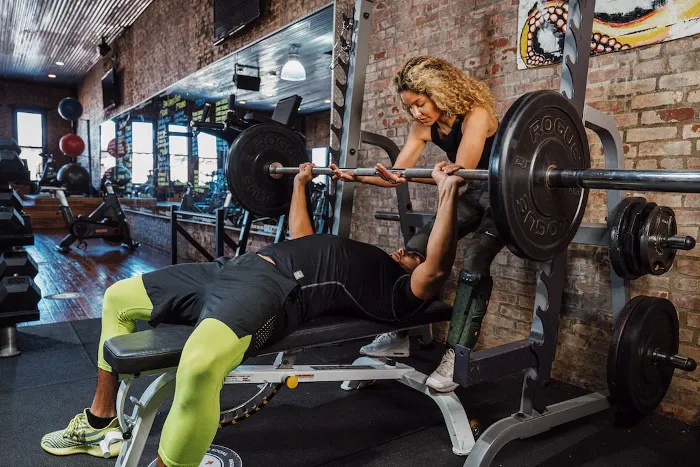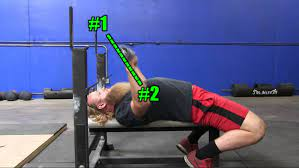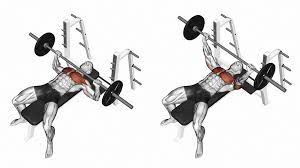Wide grip, close grip, and how to increase your bench press. (with video)

-
How to optimize and increase your bench press
-
Warm-up for bench press
-
bench press position
-
path of the bar
-
engaging back in your bench press
-
how to increase bench press strength and weight
-
Flat bench press muscles worked.
- Incline bench press muscles worked.
- What muscle groups are worked whit wide grip bench pressing
- What muscle groups are worked whit close grip bench presses
-
How to bench press to avoid injury
-
Wide grip bench press
-
close grip bench press
-
Before you go
-
conclusion
The bench press, a staple of strength training, has long been regarded as the ultimate measure of upper body power and a symbol of physical prowess. Whether you're an aspiring powerlifter, a fitness enthusiast, or simply seeking to enhance your overall strength, understanding the nuances of grip width and effective techniques to increase your bench press is crucial.
This article delves into the art and science of the bench press, exploring the significance of wide grip and close grip variations, and providing valuable insights on how to optimize your bench press performance. By understanding the mechanics behind these techniques and incorporating key strategies, you can embark on a journey towards achieving new personal bests and surpassing your previous limits.
How to optimize and increase your bench press
One of the great fitness exercises is the bench press. You can do several variations of bench presses. Still, often people think it is just pushing the bar and doesn't have any technic behind it will shove on your results. Right after I learned the technique and preparation for good benching, I went from 60kg to 80kg in a few weeks and have only been adding on after that.
So today, I will give you the recipe for a good bench press. I will tell you everything from warm-up, bar path, positioning, and using your back to better your results. I will also talk about how to do it safely, the difference between close and wide grip bench press, and what muscle groups you work with.
Warm-up for bench press
When you warm up for the bench, there are some things you should do first.
Some warm up on the chest to get the blood flowing.
Warm-up shoulders.
Warm-up/activate core.
Warm-up/activate back.
I like to use the chest flyes machine when warming up my chest. Not too heavy, so you tier your chest muscles. You can go heavy at the end if you want, but get your rest, and don't start too heavy on the bench press. You can do many chest exercises like pushups or cables, but don't do heavy compound, so you don't tire yourself out before you even begin.
bench press position
When you lay down for your press, your back should not be in contact whit the bench. A good position on the bench is when you have three contact points.
your head
your shoulders
your butt
So when you lay down, lay your head so you see just on the underside of the bar up into the roof. Then have your shoulders down and tucked in so you can hold a card between your shoulder blades. And then the beautiful arch in the back, now you can arch your back or pull yourself from a laying position up to the bar and then lay down. So you are in a kind of bridge, comfortably laying on your tucked shoulders. You just lay your butt straight down from this bridge, and you should have a good arch in your back where you have these three contact points. Whit this arch, your body is tightened up and has a lot of tension.
Now to your feet; some like to bend them under the bench so they essentially stand on their toes. But the one I would go for is when you spread wide and plant your whole foot firmly in the ground and then push your knees outwards.
If you grip the bar and push whit your feet, you will feel that you don't slide, but because you lay down on your shoulders, you push yourself down into the bench, and this energy gets pushed up into the bar.
So it helps tremendously to have this arch and push with your feet to get more power into the bar.
When you place your hands on the bar, the grip width should be so that when you let it down and push it up, there is a straight line from your wrist to your elbow, so you don't flare out too much. It gets too heavy and awkward, and having too much weight on it can be harmful.
When you do the bench press, tuck your elbows close, not all the way in, so you activate your lats for stability and help you push even heavier weights.
path of the bar

Many think you should push the bare straight up and down.
But in reality, you should go in an arch, so when you have it in the top position, it's a straight line to about the top of your chest. And then, when you take it down, lower it to about your nipples, even a bit under, and when you push it back up, you angle it. Hence, you push it towards the rack or the person spotting you until you are in an upright position again, where it is somewhere at the top of your chest and ready to repeat.
engaging back in your bench press
When you want to bench press and especially if you are going heavy, you will find it really helpful to engage your back and, for that matter, core before beginning. This has helped me push myself much more and lift heavier weights and new pr's.
When you do this, you also contact your back to the lift. That results in activating your stabilizing muscles and getting a stable lift. You can focus more of your power into the bar, which helps you transfer force into lifting the bar instead of holding it still and keeping your elbows a bit tucked in. It won't flare out, which can hurt your shoulders, but rather, you will stay compact and a machine packing all the power up into the bar.
When you have engaged your back, you will feel that you automatically "bend the bar" when you tuck your back and lats in. Don't do a lot of different exercises, so the back gets tired out. Still, a few sets may be some pull-ups and standing bent rows. When I do chest, I love to do some mid-heavyweight standing bent rows.
how to increase bench press strength and weight
If you want to see a steady incline in weight whit a bench press, you should do it regularly and consistently. But most importantly, you need progressive overload and not stay on the same weight for too long.
The first set can be 10-12 reps, then 8-10, 6-8; you can do more if you want, but the last one can be 4-6 if you do four sets. You want to work upwards of failure, so the last reps should bearly come up; so important to have a spot.
To maximize your strength and be able to lift more and lift heavier, you must take breaks and not just do one set after another. Because your muscles will be tired and won't maximize your potential, take good breaks between each set so the muscles can recover and be ready for the next set.
Flat bench press muscles worked.
When doing a flat bench press, the most worked muscles are your chest muscles, pecs, shoulders (anterior deltoids), and triceps.
When doing a flat bench press, it's the pecs that do the major work but going through the movement when you are about midway through the lift; the front delts help drive the bar up and at the top to get the bar all the way up. Your arms straight the triceps is used to straighten out your arms.
Incline bench press muscles worked.
There are a lot of different bench press variations you can do; they hit the same muscle groups but variating what grip width you have and what angle you have. It is different what muscles get worked the most.
The incline bench press focuses on the upper chest. You still hit the triceps, front deltoids, and pecs. This is an excellent exercise to build yourself a huge rack.
What muscle groups are worked whit wide grip bench pressing

When doing a wide grip bench press, you have a wide grip width that makes you focus more on the pecs and front deltoids. The pecs will have more stretch and tension with the wide grip bench press.
Usually, people are 5-6% stronger in the wide-grip bench press. Whit a wide grip, your chest and shoulders give 78% of the force needed to lift the bar, and the triceps contributes 22% of the power.
What muscle groups are worked whit close grip bench presses
As I wrote above, the same muscle groups are doing work: the front delts, pecs, and triceps. But when doing a close grip bench press, you have a smaller grip width than you usually would. This makes your triceps do more of the work.
Above, I wrote how much your shoulders and chest do and how much your triceps do what percentage. When doing a close grip bench press, the shoulders and chest muscles produce 63% of the power, and the tricep produces 37% of the power necessary to lift the bar.
How to bench press to avoid injury
In the world of gym rats, there are often injuries and often in connection whit shoulder pain. Here we can talk about how to avoid this. The two most important are warm-up and positioning.
I wrote some words on warm-up above, and for your shoulders at least to not get injured, take a gymnastic band and do some light rotation exercises or white lightweight dumbells because we all want good shoulder health.
Before you start lifting, get into position and get comfortable. Ensure everything is tucked in and you lay nicely on the bench. Now that the lifting has started watch out that you don't get out of position to push it up if it's too heavy. Don't push your shoulder forward, even if it is tempting, because you want that fucking bare up. Let your spot help you instead.
And remember to keep your wrists straight, please. You don't want to have a clicking wrist rest of your life.
You can consider getting some wrist straps to help them stay straight when doing the heaviest lifts. And if you want more power, you can get a lifting belt to get more pressure and power in the lift.
Wide grip bench press
This is how to do it if you want to work your chest and shoulders most and focus on the rack. Here you can put on a lot of muscle mass and work up the weight to get a higher training load.
close grip bench press
The close grip bench press is a good exercise also to put a lot of muscle mass on your triceps. But here, it is important to remember the elbow position.
This is an excellent way to do bench press if you want to train your triceps well too, but if you're going to increase weight and push as much as you can and improve your bench press, I will go for the wide grip bench press. But this is an excellent way to do the bench press too.
Before you go
Here you have a guide on how to do a good bench press from the bottom position all the way through. I like to give fitness tips and how to do exercises.
I have made a review on a pre work out that I won't recommend, but I put a link to a good one in that post. I will also review things like protein kreatin and other things like weight belts, wrist straps, and such.
conclusion
In conclusion, there is a lot you can do to improve your bench press and have proper form, either if you do a narrow grip bench press, shoulder-width grip, or wide grip bench press.
But most important to this, have your position and get the more advantageous position right. Take breaks and warm up so you don't get injured in your shoulder joint or other places.
And the bench press grip width has something to say if you want to exercise the tricep more or if you're going to lift heavier.
-
How to optimize and increase your bench press
-
Warm-up for bench press
-
bench press position
-
path of the bar
-
engaging back in your bench press
-
how to increase bench press strength and weight
-
Flat bench press muscles worked.
- Incline bench press muscles worked.
- What muscle groups are worked whit wide grip bench pressing
- What muscle groups are worked whit close grip bench presses
-
How to bench press to avoid injury
-
Wide grip bench press
-
close grip bench press
-
Before you go
-
conclusion